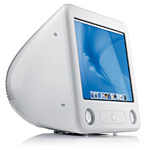Mac Musings
The 2002 vs. 2003 eMac Value Equation
Daniel Knight - 2003.05.07
Five years ago - on May 6, 1998 - Steve Jobs unveiled the original iMac. Yesterday the last G3 CRT iMac was removed from the Apple Store for Education, and a new generation of eMacs was introduced.
The original eMac was introduced just a year ago as an education-only Mac and the first Mac to offer G4 power for under US$1,000. It was released to the consumer market last June. In many ways, it was the 17" iMac many had hoped for.
The 2003 eMac offers more raw horsepower on a faster bus with improved video (including video output) at an attractive price. Today you can order a new 800 MHz eMac and have G4 power for US$799.
Entry Level
The base 800 MHz eMac includes 128 MB RAM (expandable to 1 GB),
Radeon 7500 graphics with 32 MB of dedicated  video memory, a slot for an AirPort Extreme card, and a
133 MHz system bus. This contrasts with GeForce 2 MX 3D AGP 2X video,
plain old AirPort, and a 100 MHz system bus in the 2002 eMac.
video memory, a slot for an AirPort Extreme card, and a
133 MHz system bus. This contrasts with GeForce 2 MX 3D AGP 2X video,
plain old AirPort, and a 100 MHz system bus in the 2002 eMac.
With a $200 lower list price, the new eMac offers 14% more processing power and up to 5x the wireless networking speed. In comparison with the 2002 eMac (which has been reduced to US$899 while supplies last), the newer model is the better value unless you want to burn CDs.
The only downgrade compared with the 2002 model is the inclusion of a CD-ROM drive instead of a Combo drive - but that brings us to the midrange eMac.
Midrange
At the US$999 point, the eMac boosts performance with a 1 GHz G4 processor, which provides 25% more raw processing power than today's entry level eMac and last year's top-end eMac. This model also has a larger (60 GB) hard drive and a Combo drive, allowing the user to watch DVDs and burn CDs.
For a $200 premium over the new entry level model, it's a good deal, and this will probably be the most popular unit in the line.
For $100 more than the discontinued 700 MHz Combo drive eMac, this model has 43% more processing power and a larger hard drive. I can't see any way to justify buying a new 700 MHz Combo eMac for $899 when the 1 GHz model is just $100 more.
Top End eMac
For those who want to burn DVDs, the US$1,299 eMac includes a SuperDrive, an even larger hard drive (80 GB), twice as much memory (512 MB), and the iDVD software you'll want to use when you master your DVDs. For those into digital video, that's a lot for the $300 premium over the midrange model. And the new SuperDrive burns DVDs at up to 4x, twice the speed of the old one.
In comparison to the just discontinued SuperDrive eMac (generally available for $1,199), the 1 GHz model has 25% more processing speed, a larger hard drive, and improved video. The only downgrade compared with the other eMac as that the new SuperDrive model is the only eMac that cannot boot into Mac OS 9; it can only boot OS X.
Value
Looking at the used, refurbished, and discontinued market, the best deal going is probably the refurbished Combo drive 2002 eMac available from the Apple Store for $749. For $50 less than the new entry level machine you sacrifice a bit of processing power but gain the Combo drive.
If your budget is excruciatingly tight, refurbished 700 MHz CD-ROM eMacs are available from Small Dog Electronics for $669. They don't include a modem, and by the time you add one, you may a well spend $749 for the Combo drive unit. Unless you have absolutely no need for a modem, this one isn't a good value.
New 2002 SuperDrive eMacs are overpriced in comparison to the 2003 SuperDrive model. For $100 more, the new model offers a whole lot more. But the Apple Store has some refurbished 2002 SuperDrive eMacs for $999. That's a very affordable way to gain the ability to burn your own DVDs, and the trade off in price and processing power makes it a good value.
The 2003 CD-ROM eMac includes a modem, eliminating the biggest reason to avoid last year's model. The $799 price is impressive, but as long as there's an inventory of refurbished 700 MHz Combo drive eMacs available in the same price range, the 2002 is probably the better value at this price point. The 14% difference in processing speed isn't terribly significant.
At the $999 mark, choosing between a refurbished 800 MHz SuperDrive eMac and a 1 GHz Combo drive machine boils down to one question: Will you burn DVDs? If the answer is yes, snap up those refurbs while they last. If the answer is no, go for the improved processing power, system bus, and video of the 2003 eMac.
If you're really serious about burning DVDs, the 25% additional processing power and 4x SuperDrive might be enough to justify the extra expense compared with the refurbished 800 MHz SuperDrive eMac - but you have to ask yourself whether the benefits are worth a $300 price difference. At least as long as those refurbished 2002 SuperDrive eMacs are available, they're probably the best deal for most people doing digital video.
That said, it's only the refurbished 2002 eMacs that offer a competitive value. In most cases, new inventory of the 2002 models is overpriced in comparison to the 2003 eMacs.